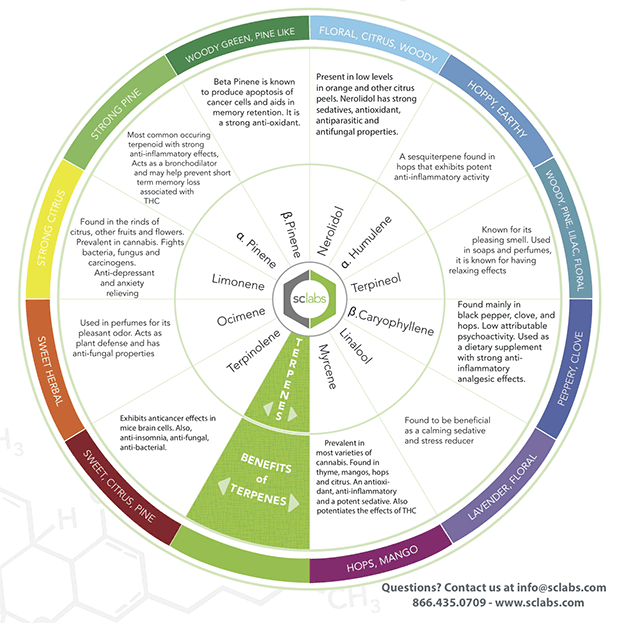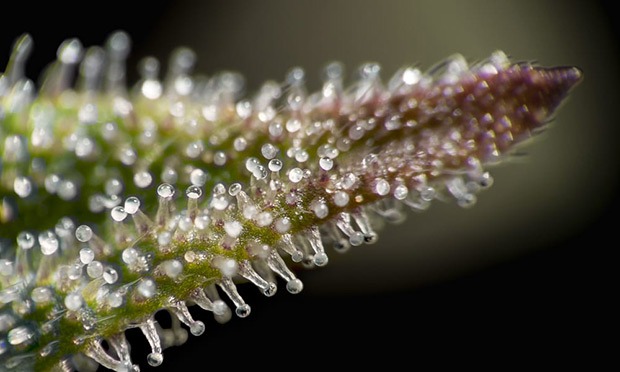Terpenes and Terpenoids: A quick note on semantics
For all the pedantic people out there, let’s make a quick distinction between terpenes and terpenoids. Yeah, you could get away with using these terms interchangeably, but there is a slight distinction that will make you appear super smart, so read carefully: The term “terpenes” is only supposed to be used for the aromatic compounds that naturally occur on the cannabis plant. Terpenoids, on the other hand, are what’s left of the terpenes after the cannabis plant has been dried and cured, which alters the chemical’s atomic structure. For this reason, some people refer to the terpene/terpenoid distinction as “wet vs. dry.” Again, unless you’re a scientist or a stickler for semantics, don’t sweat it if you mistakenly flip-flop these two terms. We do it all the time.
How do terpenes work?
It’s easy to understand how terpenes that already have antibacterial, antifungal, or antiviral properties would confer the same benefits in humans. The trickier question to answer is how terpenes can exert such profound effects on a person’s mental well-being. Although research into terpenes is ongoing, most scientists believe these compounds have such profound physiological effects because they influence the neurochemistry of our brains.
It appears various terpenes activate different neurotransmitters in a strikingly similar way to cannabinoids. Interestingly, many terpenes have been shown to work synergistically with varying cannabinoids in the body’s endocannabinoid system. For instance, certain terpenes can increase or decrease the amount of THC that enters a person’s brain.
Scientists often refer to this natural teamwork between terpenes and cannabinoids as the “entourage effect.” Although research into the “entourage effect” is still in its initial phases, it has led some scientists to promote a hands-off policy when it comes to cultivating cannabis. These researchers believe the cannabis plant already has the perfect ratio of terpenes and cannabinoids for maximal therapeutic benefit. The debate over natural versus artificial cannabis cultivation will most likely become central as the global cannabis industry evolves.
Indica/Sativa: Botany, not biology!
So, why exactly should we replace the indica/sativa distinction with varying terpene levels? The basic answer is that sativas and indicas were divided based on botany, not biology. The traditional classification will have you believe that indicas are best for relaxation and nighttime use, whereas sativas have a more “euphoric” effect and are best for daytime use. However, there’s very little data to support these physiological claims. The truth is that the effects of any cannabis strain has everything to do with the plant’s cannabinoids and terpenes rather than the plant’s indica or sativa dominance.
It is useful to remember that the primary reason botanists divided indicas from sativas had to do with their growth patterns, not their psychoactive effects. Sativas tend to grow better in equatorial climates, are taller, and have thin, light green leaves. Indicas, on the other hand, can grow in colder climates, have wider leaves, and are shorter than sativas. So, the sativa/indica distinction still has its merits for cannabis growers. When we’re talking about the effects cannabis has on a consumer, however, we need to look at cannabinoid and terpene profiles.
Terpenes as a useful tool in classifying biotypes
Fascinating research out of the lab Fundación Canna shows just how critical terpene profiles are for distinguishing between various strains of cannabis. According to recent studies, scientists found they could tell the difference between indica-dominant and sativa-dominant cannabis by merely looking at their respective terpene counts. For instance, indica-dominant strains tended to have extremely high quantities of the terpene myrcene. sativa-heavy strains, however, tended to have substantial amounts of either alpha-terpinolene or alpha-pinene.
From their research, scientists conclude that looking into terpene profiles of various cannabis plants can help cultivators better pinpoint their strain’s unique biotype. The authors of this study went so far as to say terpene analysis should be an essential part of evaluating pharmaceutical-grade cannabis before it goes to market. They warn that different terpene profiles could significantly alter the effects of cannabis strains, which means testing for terpenes, as well as cannabinoids, will be essential for the future of medicinal cannabis.
A few common terpenes and their effects
Now that we know a bit more about how terpenes work let’s take a more detailed look at some of the lesser known and yet still prominent terpenes found in the cannabis plant.
Valencene
Flavor/Aroma: Citrusy, orangey, and resembling grapefruit
Effects: Most of the research looking into valencene has examined the terpene’s potential as a natural insecticide. Amazingly, valencene seems to do just as good a job getting rid of mosquitos, ticks, and other pests as man-made chemical pesticides. Although less is known about valencene’s medicinal effects, some scientists believe it could have anti-inflammatory properties, promotes cognitive function and alertness as well as acting as a bronchodilator.
Cannabis strains with high amounts of valencene: Agent Orange, Jillybean, Tangie, and Clementine
Secondary Terpenes: Nerolidol, Decanal, and Octanal
Geraniol
Flavor/Aroma: Floral, fruity, and resembling the aroma of Geranium flowers
Effects: Like valencene, geraniol is currently being studied for its potential use as a potent insecticide. A few researchers have also suggested geraniol might have antifungal and antibacterial properties worth exploring. For instance, a few analysts claim geraniol could effectively kill bad bacteria like E. coli and fungi like Candida albicans.
Cannabis strains with high amounts of geraniol: Great White Shark, Master Kush, Afghani, and Lavender
Secondary Terpenes: Beta-geraniol and Alpha-terpineol
Terpinolene
Flavor/Aroma: Floral, fresh, citrusy, and woodsy
Effects: Terpinolene usually plays a supporting role in a cannabis strain’s flavor and aroma, but it could take center stage in the future of medicinal cannabis. A few recent studies suggest inhaling terpinolene can help patients with sleep disorders like insomnia. Although more research is needed, some even believe terpinolene could help patients struggling with heart issues and cancer. It also shows promise as an effective antibacterial and antifungal agent.
Cannabis strains with high amounts of terpinolene: Dutch Treat, Sour Tsunami, Sensi Star, Arjan’s Haze #3 and Sour Tangie
Secondary Terpenes: Phellandrene
Ocimene
Flavor/Aroma: Sweet, herbal, floral, earthy and citrusy
Effects: Initial tests suggest ocimene evolved over the centuries to protect plants and herbs from harmful microbes. For this reason, scientists are most interested in ocimene’s potential as an antiviral and antibacterial agent as well as its believed anti-inflammatory and anti-oxidant properties. Besides that, ocimene is the subject in ongoing studies as a potential treatment for type 2 diabetes and hypertension. Also, since ocimene tends to appear in cannabis strains that also have the terpene linalool, some researchers believe these compounds might favorably interact with each other.
Cannabis strains with high amounts of ocimene: Sour Diesel, White Fire OG, Chocolope, OG Kush, Amnesia, and Super Lemon Haze
Secondary Terpenes: β-Ocimene
Guaiol
Flavor/Aroma: Piney, woodsy, Floral and earthy
Effects: Guaiol from the Guaiacum plant has been used for hundreds of years in European folk medicine. Just a few diseases guaiol has been claimed to help with include the common cold, arthritis, gout, and even syphilis. Today, analysts are looking into guaiol’s antimicrobial properties to see if there’s scientific evidence to back up these traditional healing claims.
Cannabis strains with high amounts of guaiol: Liberty Haze, Kali Dog, White Widow, and Chocolope
Secondary Terpenes: δ-3-Carene
Terpenes: The cannabis world’s latest scent-sation
As the 21st century rolls on (please forgive the pun), terpenes are set to take center stage in the cannabis industry. The reason for this shift from indica/sativa to terpenes should be clear by now: terpenes offer a far more reliable way to measure a plant’s physiological effects. Cultivators are already experimenting with harvesting crops for specific terpene profiles. Plus, many cannabis vendors now clearly list terpene counts on their products.
Although there’s debate over how far cultivators should go in artificially manufacturing their terpenes, it’s clear that these aromatic compounds will become more prominent as cannabis legalization increases and we will soon be measuring cannabis effectiveness by the terpene profile rather than the old “indica-sativa” adage.

